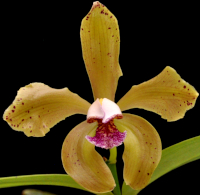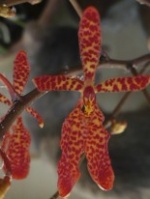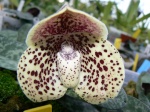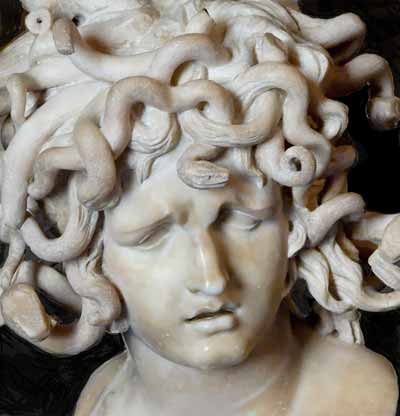Habenaria : question de nomenclature
+4
Lotoise
Maryse 81
Rominou
eorchids
8 participants
Forum Orchidées : Tout un monde à découvrir :: Orchidées Terrestres :: Tout savoir sur les Orchidées Terrestres :: Culture : questions générales et partage d'expérience
Page 1 sur 1
 Habenaria : question de nomenclature
Habenaria : question de nomenclature
Je viens de corriger une série de titre dans les Habenaria (je ne remercie pas les modérateurs de la section  ), pour changer "medusae" voire "medusea" en "medusa".
), pour changer "medusae" voire "medusea" en "medusa".
En vérifiant sur Kew, je m'aperçois que H. medusa et H. myriotricha sont 2 espèces distinctes (bien que R. Govaerts ne semble pas d'accord) alors qu'elles sont citées en synonyme dans la majorité des sujets du site.
Quelqu'un pourrait nous expliquer la différence entre les 2 et corriger si besoin l'ensemble des sujets concernés ?
Merci.
 ), pour changer "medusae" voire "medusea" en "medusa".
), pour changer "medusae" voire "medusea" en "medusa".En vérifiant sur Kew, je m'aperçois que H. medusa et H. myriotricha sont 2 espèces distinctes (bien que R. Govaerts ne semble pas d'accord) alors qu'elles sont citées en synonyme dans la majorité des sujets du site.
Quelqu'un pourrait nous expliquer la différence entre les 2 et corriger si besoin l'ensemble des sujets concernés ?
Merci.

Dernière édition par eorchids le Mar 15 Sep 2015 - 9:39, édité 1 fois
______________________________________________________________________________________________________________________________
Eric, frappé par la foudre orchidophile en 1980.
 Re: Habenaria : question de nomenclature
Re: Habenaria : question de nomenclature
J'avais trouvé ça quand je m'étais posé la question :
H. medusa is considered a valid name for plants native to Indonesia while H. myriotricha are applied to plants in Vietnam and Laos.
______________________________________________________________________________________________________________________________
C'est à moi !




Rominou-
 Messages : 12387
Messages : 12387
Date d'inscription : 25/04/2013
Age : 43
Localisation : Chantilly (60)
 Re: Habenaria : question de nomenclature
Re: Habenaria : question de nomenclature
Et comme on a acheté nos plantes en Europe, on a aucune idée de leur provenance 
J'en étais resté à l'idée que medusa et myriotricha étaient 2 synonymes



J'en étais resté à l'idée que medusa et myriotricha étaient 2 synonymes




Maryse 81-
 Messages : 6018
Messages : 6018
Date d'inscription : 27/01/2013
Age : 56
Localisation : Saint Gaudens (31)
 Re: Habenaria : question de nomenclature
Re: Habenaria : question de nomenclature
Du coup, je retrouve les liens que j'avais visité, là aussi il y a un troisième invité, Habenaria beccarii :
Source : http://tulear.blogspot.fr/2008/07/pure-beauty-habenaria.html
According to Seidenfaden, there are 3 species - H. medusae from northern Sumatra, H. myriotricha from Thailand/Laos & H. beccarii from Sulawesi. H. medusae and H. myriotricha are almost identical while H. beccarii has broader and shorter fringes on the side lobes.
Source : http://tulear.blogspot.fr/2008/07/pure-beauty-habenaria.html
______________________________________________________________________________________________________________________________
C'est à moi !




Rominou-
 Messages : 12387
Messages : 12387
Date d'inscription : 25/04/2013
Age : 43
Localisation : Chantilly (60)
 Re: Habenaria : question de nomenclature
Re: Habenaria : question de nomenclature
Et bien moi, j'ai ça mais je n'ai pas capté tous les détails :



Sérieusement, merci Romain pour tes réponses.



Sérieusement, merci Romain pour tes réponses.

______________________________________________________________________________________________________________________________
Eric, frappé par la foudre orchidophile en 1980.
 Re: Habenaria : question de nomenclature
Re: Habenaria : question de nomenclature



______________________________________________________________________________________________________________________________
C'est à moi !




Rominou-
 Messages : 12387
Messages : 12387
Date d'inscription : 25/04/2013
Age : 43
Localisation : Chantilly (60)
 Re: Habenaria : question de nomenclature
Re: Habenaria : question de nomenclature
Eric, tu y mets beaucoup de mauvaise volonté ... 

______________________________________________________________________________________________________________________________
La philosophie nous enseigne à douter de ce qui nous paraît évident. La propagande, au contraire, nous enseigne à accepter pour évident ce dont il serait raisonnable de douter. A. Huxley

Lotoise- Administrateur
-
 Messages : 37181
Messages : 37181
Date d'inscription : 17/12/2012
Localisation : Sud Ouest/Aquitaine/47
 Re: Habenaria : question de nomenclature
Re: Habenaria : question de nomenclature
Ah bon ? Pourtant, je cherche des textes de référence, issus de cultivateurs locaux. Je ne comprends pas cette réflexion. Je suis très peiné. 




C'est ce qu'on voulait sur ce forum, du sérieux, du scientifique, du lourd quoi !

 , cela me parait capital dans les informations de ce sujet. Pfff...
, cela me parait capital dans les informations de ce sujet. Pfff... 
Je crois que cela signifie : Pu****, quelle salo***** de question à la c** ou un truc dans ce genre. C'est un idéogramme assez approximatif dans le graphisme, impossible d'être plus précis dans la traduction surtout quand il est doublé en fin de phrase.
J'ai ça aussi :
Mais la, j'avoue que cette réponse me laisse perplexe :
Je ne sais pas si vous partagez mon avis.
Bon... je crois que je vais retourner travailler.




C'est ce qu'on voulait sur ce forum, du sérieux, du scientifique, du lourd quoi !

Tu ris, tu ris mais ça :Rominou a écrit:



 , cela me parait capital dans les informations de ce sujet. Pfff...
, cela me parait capital dans les informations de ce sujet. Pfff... 
Je crois que cela signifie : Pu****, quelle salo***** de question à la c** ou un truc dans ce genre. C'est un idéogramme assez approximatif dans le graphisme, impossible d'être plus précis dans la traduction surtout quand il est doublé en fin de phrase.
J'ai ça aussi :
Habenaria medusa - อั้วปากฝอย
Habenaria medusa หรืออั้วปากฝอย จริงๆแล้วก็ยังสับสนอยู่กับ Habenaria myriotricha บางทีอาจจะเป็นตัวเดียวกันก็ได้ จัดเป็นกล้วยไม้ดินที่งามแปลกตาไปอีกแบบหนึ่งเนื่องจากกลีบปากที่โดดเด่น ก้านช่อที่ยาวสูงและกลีบดอกขาวสะอาด
อั้วปากฝอยเป็นกล้วยไม้กลุ่มเดียวกับลิ้นมังกร ในเมืองไทยมีกล้วยไม้กลุ่มนี้อยู่จำนวนมากประมาณ 36 ชนิด เรียกรวมๆกันว่าลิ้นมังกรและนางอั้ว คนไทยไม่ค่อยนิยมไม้กลุ่มนี้ซักเท่าไหร่เนื่องจากค่อนข้างไม่เข้าใจวิธีเลี้ยงจึงคิดว่าเลี้ยงยากแตกต่างจากพวกฝรั่งที่นิยมไม้กลุ่มนี้เอามากๆ เนื่องจากไม้กลุ่มนี้มีลักษณะคล้ายคลึงกับกล้วยไม้กลุ่ม orchis ซึ่งเป็นกล้วยไม้พื้นเมืองทางยุโรป ให้ดอกช่วงฤดูใบไม้ผลิและเหลือเพียงหัวใต้ดินในฤดูอื่นๆ ชาวตะวันตกจึงคุ้นเคยกับลักษณะนิสัยเช่นนี้เป็นอย่างดี
ว่าไปแล้วไม้ตัวนี้จับถ่ายรูปยากจริงๆ หรือฝีมือผมไม่ได้เรื่องกันแน่ จะถ่ายข้างๆก็ดูแปลกๆ ซ้ายที ขวาที ก็สู้หน้าตรงๆไม่ได้ ส่องจนตาจะเหล่ไปข้างหนึ่งแล้วนะเนี่ย
Mais la, j'avoue que cette réponse me laisse perplexe :
พวกนู๋ๆเข้าแถวกันมา เอิ๊กๆๆ
ดอกนี้สวยแปลดีจังครับ บล็อกก่อนๆก็มี
ไม้แปลกตาเยอะ เจอเซียนอีกคนแล้วมั้งเนี่ย
จะต้องมาซูฮก
ขอแอดไปด้วยนะครับ
Je ne sais pas si vous partagez mon avis.

Bon... je crois que je vais retourner travailler.

______________________________________________________________________________________________________________________________
Eric, frappé par la foudre orchidophile en 1980.
 Re: Habenaria : question de nomenclature
Re: Habenaria : question de nomenclature
Je rappelle, à toutes fins utiles, que la question de départ était très sérieuse.
Et que, compte-tenu de mon rang sur ce forum, je ne peux être tenu responsable des dérives qu'on peut lire.
Et que, compte-tenu de mon rang sur ce forum, je ne peux être tenu responsable des dérives qu'on peut lire.

______________________________________________________________________________________________________________________________
Eric, frappé par la foudre orchidophile en 1980.
 Re: Habenaria : question de nomenclature
Re: Habenaria : question de nomenclature
eorchids a écrit:
Et que, compte-tenu de mon rang sur ce forum, je ne peux être tenu responsable des dérives qu'on peut lire.
N'importe quoi pourvu que ça mousse !



______________________________________________________________________________________________________________________________
La philosophie nous enseigne à douter de ce qui nous paraît évident. La propagande, au contraire, nous enseigne à accepter pour évident ce dont il serait raisonnable de douter. A. Huxley

Lotoise- Administrateur
-
 Messages : 37181
Messages : 37181
Date d'inscription : 17/12/2012
Localisation : Sud Ouest/Aquitaine/47
 Re: Habenaria : question de nomenclature
Re: Habenaria : question de nomenclature
un peu de sérieux... Je vous laisse décortiquer les infos. 
THAI FOR. BULL. (BOT.), SPECIAL ISSUE: 7–105. 2009. The genus Habenaria (Orchidaceae) in Thailand
Et :

THAI FOR. BULL. (BOT.), SPECIAL ISSUE: 7–105. 2009. The genus Habenaria (Orchidaceae) in Thailand
1. Habenaria holotricha Gagnep., Bull. Soc. Bot. France 78: 70. 1931; Seidenf., Bot. Tidsskr. 68: 42. 1973; Dansk Bot. Ark. 31(3): 69. 1977; Opera Bot. 114: 56. 1992.— Medusorchis holotricha (Gagnep.) Szlach., Orchidee (Hamburg) 55: 489. 2004. Type: Indochina, possibly Laos, no exact locality, Massie s.n. (lectotype P, designated here, barcode P00426990!).—Habenaria andamanica auct. non Hook.f.: Seidenf. & Smitinand, Orchids Thailand: 27. 1959.— Habenaria polytricha auct. non Rolfe: Seidenf., Bull. Mus. Paris 3, s. 71, Bot. 5: 132. 1973.
Terrestrial, deciduous. Stems to 100 cm tall. Leaves 6–10, spreading, cauline and scattered in the middle part of the stem, lanceolate-elliptic, acute or acuminate, mucronate, 13–21 by 3.5–5.1 cm. Bract-like leaves 6, lower spreading and upper largely erect, lanceolate, acuminate, 3.3–10 cm long, not or only shortly sheathing. Infl orescences semi-dense, many-fl owered; rachis 31 cm long; fl oral bracts lanceolate, acuminate, 25–48 by 4–6 mm. Flowers 26–38 mm across; variegated dark red, orange and white; sepals and petals also reported as pale brown and lip white. Ovary (including pedicel) 18–22 mm long. Sepals long-acuminate, 5-veined; median sepal erect, elliptic-ovate, 15–19 by 5–8 mm; lateral sepals spreading, slightly obliquely elliptic-ovate, 17–19 by 5–7.5 mm. Petals suberect, bilobed, both lobes split into several acute linear laciniae 18–25 mm long. Lip 21–28 mm long, split into acute linear laciniae 18–23 mm long, with a basal united 5–6.5 by 2–2.6 mm large part; spur cylindric, 17–20 mm long, thickened in the upper part. Gynostemium 4–6 mm long, anther canals ca 2 mm long, stigmas ca 3 mm long.
Thailand.— NORTHERN: Chiang Mai [Mae Rim, Nanakorn et al. 12630 (QBG
[s]); Doi Inthanon, Garrett 478 (C [s], K)]; NORTH-EASTERN: Loei [Na Haew, Pumicong
& Maknoi 488 (QBG, QBG [s])]; without exact locality, BCU s.n. (BCU [s] 008922) [4
collections seen].
Distribution.— Laos.
Ecology.— In moist upper deciduous forest, also found in limestone crevices; 900–2000 m altitude. Flowering: Aug.–Oct.
Conservation.— Material from only three widely scattered specifi ed localities and one unknown locality was available. The species was listed in a book on threatened plants of Thailand (Suddee, 2005: 130). IUCN red list category ‘Endangered’ based on geographic range and decline (B2a,b(iii); IUCN, 2001).
Illustrations.— Seidenf., Bot. Tidsskr. 68: fi gs. 8–9. 1973; Bull. Mus. Natl. Hist. Nat. 3, s. 71, Bot. 5: fig. 4. 1972; Dansk Bot. Ark. 31(3): fig. 35. 1977.
Notes.— In tropical SE Asia there are several Habenaria species with the lip side-lobes deeply split into a large number of filiform lobes, and two subgroups can be distinguished. The first comprises those species that have bilobed petals which are often further split into laciniae (including H. holotricha, H. ternatea Rchb.f., H. andamanica Hook.f., H. polytricha Rolfe), while the other group has entire petals (among others H. medioflexa, H. myriotricha, H. trichosantha, H. medusa Kraenzl., H. beccarii Schltr.).
Diagnostic characters within the group are the number of the lobes of the petals and the lip, the sepal size and the spur length. The taxonomy of the group was discussed by Seidenfaden (1973) who pointed out that the differences between the species are very small and that a thorough study of the entire group is needed in order to clarify the relationships and to determine whether all species are sufficiently distinct to be recognised. The only Thai species with laciniate-split lip lobes and two-lobed petals is H. holotricha. The plant had originally been identified as H. andamanica which is indeed very close, and in future may prove to be conspecific.
Et :
11. Habenaria myriotricha Gagnep., Bull. Soc. Bot. France 78: 72. 1931; Seidenf., Bot. Tidsskr. 68: 43. 1973; Opera Bot. 114: 60. 1992.— Fimbrorchis myriotricha (Gagnep.) Szlach., Orchidee (Hamburg) 55: 491. 2004. Type: Laos, Cam-keut, Spire 260 (lectotype P, designated here, barcode P00430640!).— Habenaria mediofl exa auct. non Turrill: Kerr, Nat. Hist. Bull. Siam Soc. 23: 188. 1969.— Habenaria medusa auct. non Kraenzl.: Seidenf., Bull. Mus. Nat. Hist. Natl. III, 71: 132. 1972.
Terrestrial or rarely epilithic, deciduous, glabrous except sometimes for the bract margins. Stems 19–40 cm tall. Cataphylls 3, tubular, sheathing, covering the stem to 4 cm high. Leaves (2–)4–5, spreading, cauline and scattered in the lower two thirds of the stem, lanceolate, acute or acuminate, mucronate, 8–15 by 2–2.5 cm, sometimes with insignificant pale semi-translucent border. Bract-like leaves 1–3, erect, lanceolate-ovate, acuminate, (2–)3–4.4 cm long, not sheathing, with prominent or obscure pale semi-translucent border, margins minutely denticulate or shortly glandular-hairy. Inflorescences lax, fewflowered; rachis 3–4 cm long; fl oral bracts narrowly lanceolate, acuminate, 15–25 by 2–5 mm, margins entire, elongate-papillose or shortly glandular-hairy. Flowers white with green sepals and petals, lip often with some red at the base. Ovary (including pedicel) 20–40 mm long. Sepals acute, 3-veined, often with papillose margins; median sepal erect, ovate, 8–8.5 by 4–4.2 mm; lateral sepals spreading to somewhat refl exed, obliquely ovate, 7.5–11.5 by 4.75–4.9 mm, basally united with the lip. Petals erect, forming a hood with the median sepal, linear, acute or obtuse, 1-veined, 7–8 by 0.5–1 mm, margins papillose.
Lip 18–25 mm long, deeply 3-lobed above basal united part of 4.5–7 mm; midlobe linearoblong,
convex, more or less papillose, 4–8 by 0.7–1 mm; side-lobes 13–23 mm long, divided into 15–17 laciniae 11.5–20 by 0.25–0.3 mm long; spur cylindric, 31–40 mm long, often thickened in the apical half. Gynostemium 3.5–4.5 mm long, with a short basal stalk, anther erect, anther canals 1.7–3 mm long, straight projecting forwards; auricles rounded small bulges next to the anther.
Thailand.— NORTHERN: Tak [Mae Sot, Songkakul 124 (BKF [s]); Umphang,
Triboun & illegible 1578 (l) (BK [s])]; Kamphaeng Phet [Mae Lamung, Kerr 467 (K)];
WITHOUT LOCALITY: Pumicong 460 (QBG, QBG [s]); Thaithong 1224 (BCU [s]);
Tiptabiankarn 6915 (Suan Luang [s]) [6 collections seen].
Distribution.— Laos and Vietnam.
Ecology.— Mostly unknown, once reported in a crevasse in limestone rock, 600 m altitude. Flowering: June–Sept.
Conservation.— Three collections from scattered localities in northern Thailand and three from unspecifi ed localities are known, none of which appear to be situated inside nature conservation areas. IUCN red list category ‘Vulnerable’ based on geographic range and decline (B2a,b(iii); IUCN, 2001).
Illustrations.— Seidenf., Bull. Mus. Nat. Hist. Natl. III, 71: fi g. 3. 1972; Dansk
Bot. Ark. 31(3): fig. 50. 1977.
Notes.— In this treatment I follow Seidenfaden (1992: 60) and Vaddhanaphuti (2005: 166) who maintain Habenaria myriotricha as a separate species. Based on his recent studies Seidenfaden (1992) doubted his earlier opinion that H. myriotricha is conspecific with the Indonesian H. medusa Kraenzl. (Seidenfaden, 1972; 1973), but at the same time he pointed out that in the whole group of Habenaria species with laciniate lips the available material is too scarce for studies on the variability of the plants.
Nevertheless, Kew’s World Checklist of Monocotyledons (http://www.kew.org/wcsp/monocots/), Schuiteman et al. (2008) and Cavestro (2007: 206) consider the two taxa as conspecific. Interestingly, neither of the two appear to occur in Peninsular Malaysia as H. myriotricha is known from Laos, Vietnam and Thailand while H. medusa is found in Sumatra, Java, Borneo and Sulawesi. Although such distribution gaps are indeed known to occur in plants, it adds further doubt to the possible conspecificity of the two taxa.
The differences between this species and the following Habenaria trichosantha are also very slight, both being characterised by narrow, entire petals, deeply dissected lips and gynostemia with rather low auricles. They seem to be distinguished merely by flower size: H. myriotricha has smaller fl owers with median sepals measuring 8–8.5 mm in length, while H. trichosantha has median sepals longer than 10 mm.
Dernière édition par eorchids le Mar 15 Sep 2015 - 23:34, édité 1 fois
______________________________________________________________________________________________________________________________
Eric, frappé par la foudre orchidophile en 1980.
 Re: Habenaria : question de nomenclature
Re: Habenaria : question de nomenclature
eorchids a écrit:Je viens de corriger une série de titre dans les Habenaria (je ne remercie pas les modérateurs de la section), pour changer "medusae" voire "medusea" en "medusa".
En vérifiant sur Kew, je m'aperçois que H. medusa et H. myriotricha sont 2 espèces distinctes (bien que R. Govaerts ne semble pas d'accord) alors qu'elles sont citées en synonyme dans la majorité des sujets du site.
Quelqu'un pourrait nous expliquer la différence entre les 2 et corriger si besoin l'ensemble des sujets concernés ?
Merci.
Et bien oui toi!

mb24- Modérateur spécialisé en changement d'étiquette
-
 Messages : 20499
Messages : 20499
Date d'inscription : 01/02/2014
 Re: Habenaria : question de nomenclature
Re: Habenaria : question de nomenclature

 Je me suis bien marrée en lisant vos délires....
Je me suis bien marrée en lisant vos délires.... 
______________________________________________________________________________________________________________________________
"La patience est l'art d'espérer" Vauvenargues
"A goal without a date is just a dream" Milton H. Erickson

Josiane71-
 Messages : 12881
Messages : 12881
Date d'inscription : 12/08/2014
Localisation : Saône et Loire
 Re: Habenaria : question de nomenclature
Re: Habenaria : question de nomenclature
Merci Michel mais je ne suis pas certain de ... enfin... 
Padkoi Josiane, on mélange l'utile à l'agréable.

Padkoi Josiane, on mélange l'utile à l'agréable.

______________________________________________________________________________________________________________________________
Eric, frappé par la foudre orchidophile en 1980.
 Re: Habenaria : question de nomenclature
Re: Habenaria : question de nomenclature
J'ai bien fait de le pas poster la floraison que j'ai eu, je me serai trompé dans l'orthographe du titre.




______________________________________________________________________________________________________________________________
Didier, grand débutant, culture en petite serre, environ huit orchidées encore vivantes, fashion victim de la dernière orchidée à la mode, militant pour la possibilité d'avoir un avatar créatif comprenant une orchidée.
Trumpo
 Re: Habenaria : question de nomenclature
Re: Habenaria : question de nomenclature
rien à dire si ce n est que je pense que souvent une même plante en fonction de sa provenance arrive je ne sais par quelle bizarrerie à avoir plusieurs noms reconnu !!!
______________________________________________________________________________________________________________________________
http://desorchideesdanslejardin.overblog.com/(toujours en construction)
Forum Orchidées : Tout un monde à découvrir :: Orchidées Terrestres :: Tout savoir sur les Orchidées Terrestres :: Culture : questions générales et partage d'expérience
Page 1 sur 1
Permission de ce forum:
Vous ne pouvez pas répondre aux sujets dans ce forum










